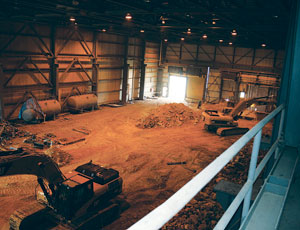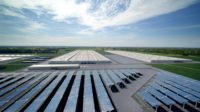The nuclear industry is sprinting to build nuclear-enrichment plants in the U.S. before its supply of en-riched uranium dries up in 2013. Bethesda, Md.-based USEC Inc. is building a $3.5-billion enrichment plant at the site of its shuttered plant in Piketon, Ohio. Louisiana Energy Services (LES), a subsidiary of U.K.-based Urenco Ltd., is building a $3-billion enrichment plant at a greenfield site in Eunice, N.M., and Paris-based Areva is seeking approval to build an enrichment facility at a greenfield site near Idaho Falls at cost of more than $2 billion.


All three facilities will use a gas-centrifuge technology that has been used in Europe for years, but not in the U.S. Additionally, GE-Hitachi Nuclear Energy is considering a fourth plant that would use lasers to enrich uranium, near its headquarters in Wilmington, N.C.
When the three centrifuge plants are operating at full capacity, they will supply just enough enriched uranium for all of the nation’s current nuclear plants.
The Dept. of Energy has set aside $2 billion for loan guarantees for new enrichment facilities. USEC and Areva have both applied for the full amount. LES has not applied for a guarantee.
The modular design of all the plants allows for expansion even while enrichment is occurring, says Sam Shakir, president of Areva Enrichment Services. “If we see the market expanding as we anticipate, then we can keep going” after the initial infrastructure is built, he says.
USEC’s Paducah, Ky., plant now is the only source of enriched uranium in the U.S. The rest of the enriched uranium is imported, with 40% to 50% of the entire U.S. supply coming from Russia’s program to turn nuclear weapons-grade material into fuel. But that “Megatons to Megawatts” program ends in 2013. The Paducah plant, though, uses 50-year-old gaseous-diffusion technology that needs a huge amount of electricity.
In 2000, USEC began a move to centrifuge technology, which uses 95% less power. USEC is in the middle of a massive reconstruction of its Piketon plant. Irving, Texas-based Fluor Corp. has a $1- billion engineering, procurement and construction contract for the 1.7 million sq-ft facility, which was stripped to its shell. First commercial production is expected in 2010.
LES is expected to begin commercial production in late 2009. San Francisco-based URS Corp. is providing construction and construction management for the structures, which enclose about 1 million sq ft.
Both LES and Areva will use the same centrifuge design, while USEC has its own design. Under a $500-million contract, The Babcock and Wilcox Co., Barberton, Ohio, will manufacture most of the centrifuge. Honeywell Technology Solutions Inc., Columbia, Md., has a $78-million contract to perform final installation of the centrifuges.
“This whole program is critical for resurgence of nuclear industry,” says Carl Durham, president and general manager of BWXT Clinch River, Oak Ridge, Tenn., which will supply parts for the B&W centrifuge.

Post a comment to this article
Report Abusive Comment